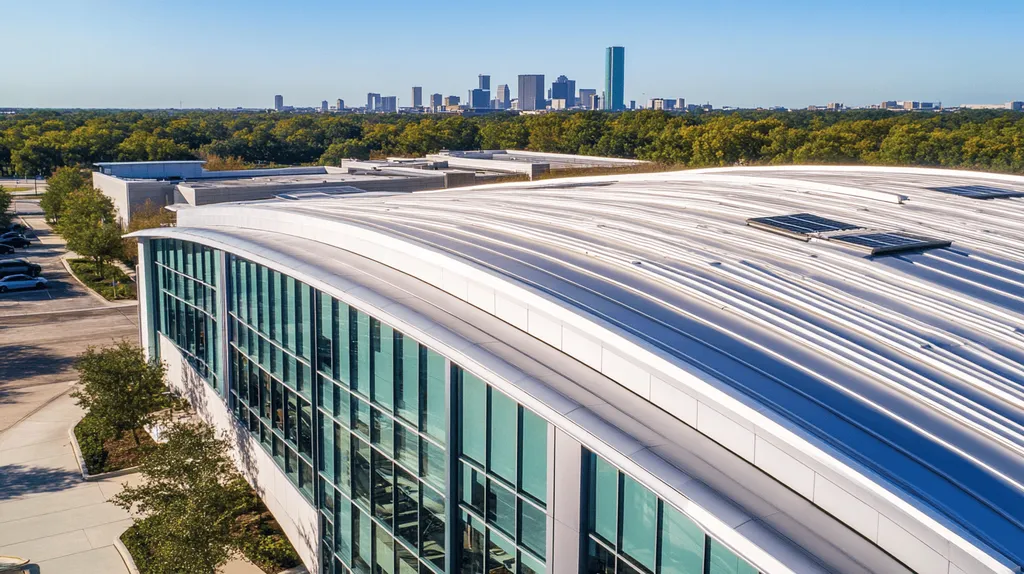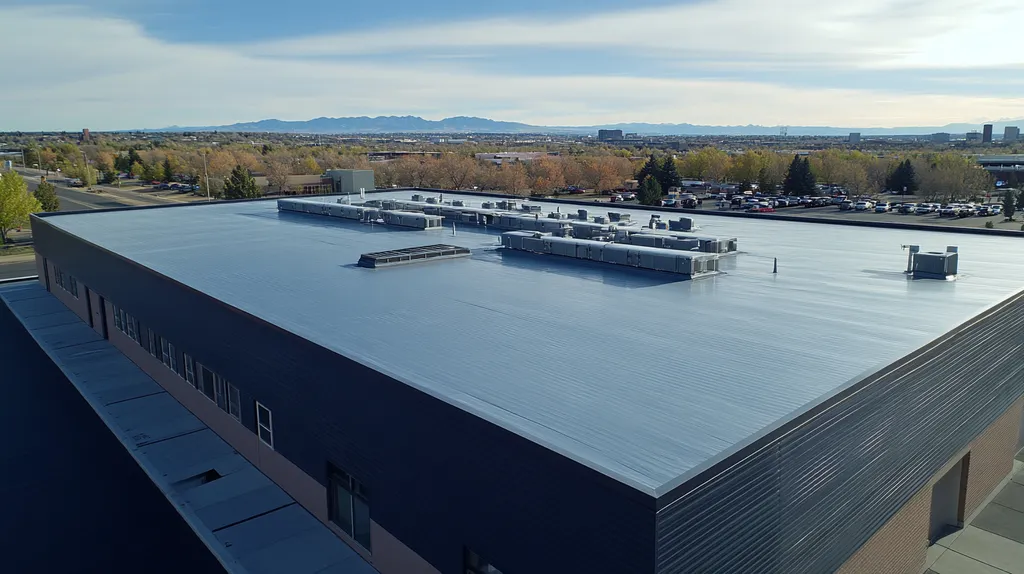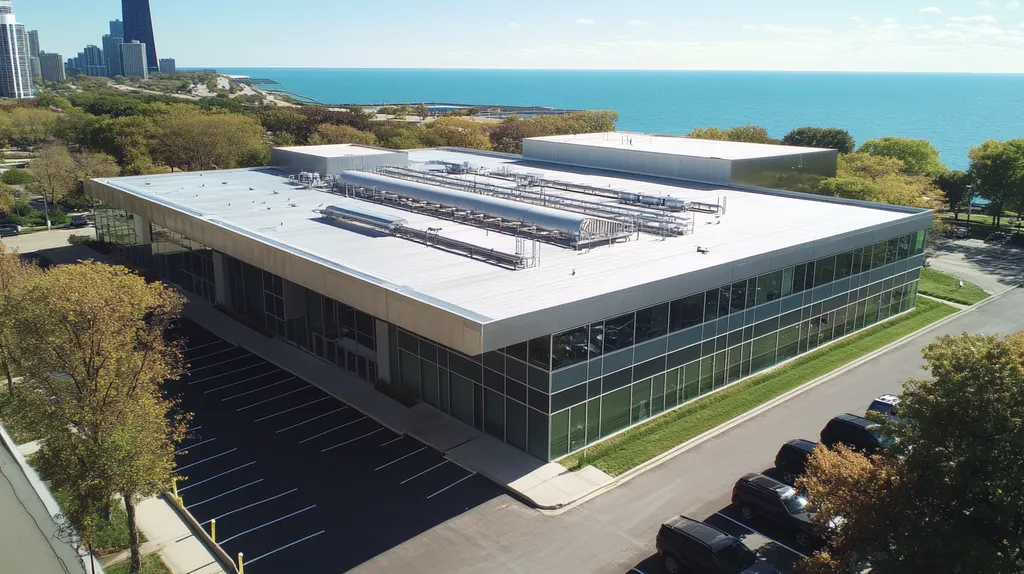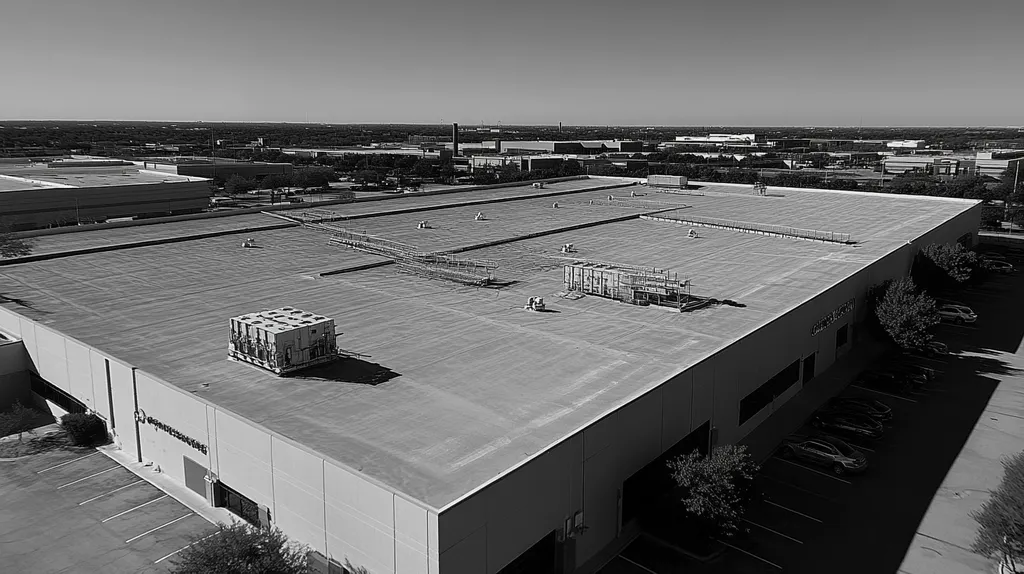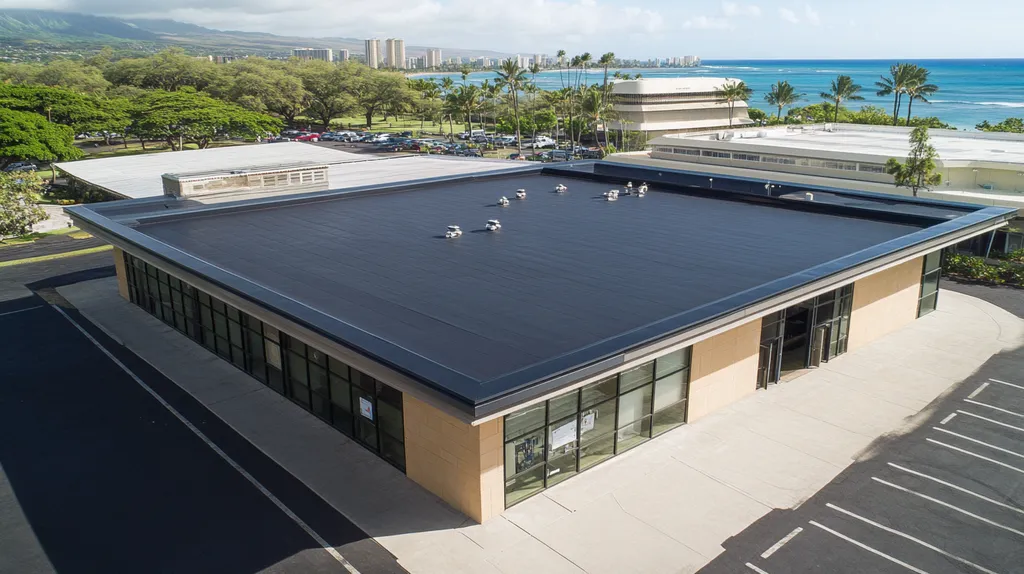Every year, commercial building owners lose millions of dollars to preventable rooftop equipment damage that compromises their roofing systems. Industry data shows that 70% of premature roof failures stem directly from equipment-related issues.
From HVAC units to satellite dishes, the growing array of rooftop equipment creates complex challenges for maintaining roof integrity and building performance. Without proper planning and maintenance, these essential systems often become liability points that threaten both operational efficiency and structural stability.
This comprehensive guide separates fact from fiction regarding rooftop equipment impacts, providing property owners and facility managers with evidence-based strategies to protect their investments.
SECTION 1: COMMON MISCONCEPTIONS
When it comes to commercial rooftop equipment, what property owners don’t know can cost them millions in repairs and premature roof replacement. Every year, preventable equipment-related damage leads to structural failures, energy waste, and water infiltration that compromise building integrity. Understanding these common misconceptions is critical for protecting your investment and avoiding catastrophic failures that can shut down operations.
Rooftop Equipment Placement Myths
The most dangerous myth about rooftop equipment is that proper installation alone ensures long-term performance. Even correctly installed units can cause devastating damage if placed without considering the roof’s load paths and structural design.
Equipment clustering presents another hidden risk. While grouping units may seem efficient for maintenance access, it can create dangerous stress concentrations that exceed the roof’s designed load capacity.
Many facility managers assume that roof warranties protect against equipment-related damage. However, improper equipment placement often voids these warranties, leaving buildings vulnerable to costly repairs that insurance won’t cover.
Equipment vibration effects are frequently overlooked during placement decisions. Over time, even minor vibrations can weaken surrounding roof materials and fasteners, creating paths for water infiltration that may not become apparent for months or years.
Weight vs. Foot Traffic Misunderstandings
Static equipment weight and dynamic foot traffic stress affect roofs differently, yet many owners treat them as interchangeable concerns. While a roof might adequately support a 2,000-pound HVAC unit, regular foot traffic around that unit can cause more damage than the equipment itself.
The cumulative impact of maintenance activities often goes unrecognized. Each service visit creates wear patterns that, when combined with equipment weight, accelerate membrane deterioration in critical areas.
Walk pad installation is commonly viewed as a complete solution for foot traffic protection. However, improperly placed walk pads can trap moisture and create new stress points that compromise roof integrity.
Temperature fluctuations magnify the impact of both equipment weight and foot traffic. As roofing materials expand and contract, these combined stresses can create tears and separations that might not be visible during routine inspections.
Drainage and Ventilation Misconceptions
The biggest drainage misconception is that equipment placement won’t significantly affect water flow. In reality, even small obstructions can create damaging ponding conditions that multiply the stress on roofing systems.
Many owners assume existing drainage patterns will remain effective after equipment installation. However, new units can redirect water flow in unexpected ways, creating pressure points that weren’t considered in the original roof design.
Ventilation requirements are often misunderstood when planning equipment layout. Proper airflow isn’t just about equipment efficiency – it’s crucial for preventing moisture accumulation that can degrade roofing materials from the inside out.
The relationship between equipment placement and thermal movement is frequently overlooked. Poor ventilation planning can create hot spots that accelerate material aging and increase energy costs throughout the building.
Winter conditions amplify these challenges, as blocked drainage and inadequate ventilation can lead to ice dam formation. These issues often remain hidden until spring thaws reveal extensive damage to both roofing systems and interior spaces.
SECTION 2: PRACTICAL IMPLICATIONS
Commercial rooftop equipment poses a $3.3 billion annual maintenance challenge for building owners. Every piece of equipment installed creates potential failure points that can compromise roof integrity and building operations. Understanding these practical implications is essential for protecting both equipment investments and the roofing system itself, as seemingly minor oversights can cascade into major structural and operational issues.
Roofing Material Wear and Tear
Equipment placement creates concentrated stress points that accelerate membrane aging and deterioration. These high-stress zones experience up to three times the normal wear rate, particularly around equipment supports and penetrations.
Membrane compression from equipment weight alters the roof’s natural expansion and contraction patterns. This disruption can create tears and separation at seams, even when the initial installation followed best practices.
UV exposure compounds these stresses, particularly around equipment that blocks natural water flow. These areas often experience ponding water that amplifies UV damage and accelerates material breakdown.
Chemical exposure from equipment leaks or maintenance materials presents another hidden threat. Even minor fluid leaks can degrade roofing materials over time, creating weak points that compromise the entire system.
Environmental Factors Impacting Equipment
Temperature fluctuations create thermal stress that affects both equipment performance and roof integrity. Daily cycles of heating and cooling can cause equipment supports to shift and create new pressure points on the roof surface.
Wind exposure at roof level influences equipment stability and maintenance requirements. Units facing prevailing winds typically require more frequent servicing and are more likely to develop leaks around their mounting points.
Moisture accumulation beneath equipment creates ideal conditions for material degradation. Poor ventilation around units can trap humidity, accelerating rust formation and weakening mounting systems.
Ice formation around equipment bases presents particular challenges in cold climates. The freeze-thaw cycle can gradually separate equipment from its mounting points, creating potential failure points in both the equipment and roof system.
Maintenance Strategies for Longevity
Regular equipment inspection must extend beyond operational checks to include mounting systems and surrounding roof areas. Monthly visual inspections can identify developing issues before they create significant damage.
Establishing clear maintenance access paths helps prevent random foot traffic that can damage roofing materials. Designated walkways should account for all routine service points while minimizing crossover with critical drainage paths.
Coordinating equipment and roof maintenance schedules maximizes efficiency and reduces redundant roof traffic. This integrated approach ensures that repairs to either system don’t inadvertently damage the other.
Documentation of all rooftop activities, including equipment service dates and repair locations, creates a valuable diagnostic tool. This data helps identify patterns of wear and predict potential failure points before they develop.
Implementing a comprehensive drainage maintenance program around equipment prevents water accumulation that can compromise both systems. Regular cleaning of drains and scuppers particularly near equipment installations should be a top priority.
SECTION 3: COST OF MISINFORMATION
Poor decisions about rooftop equipment create a devastating financial ripple effect across commercial properties. Industry data shows that equipment-related roof damage costs U.S. businesses over $2.5 billion annually in preventable repairs and premature replacements. These losses extend far beyond direct repair costs, impacting building operations, energy efficiency, and long-term property values.
Financial Impact of Premature Replacement
Commercial roof replacements typically range from $12 to $25 per square foot, with equipment-dense areas driving costs toward the upper end. A 50,000-square-foot roof replacement can easily exceed $1 million when accounting for equipment removal, reinstallation, and temporary facility disruption.
Most commercial roofs should last 20-25 years with proper maintenance. Studies of TPO roofs installed between 8 and 16 years ago demonstrate they consistently perform above ASTM standards for new materials, indicating many replacements occur unnecessarily. (source: GAF Roofing)
Equipment-related damage triggers approximately 40% of premature replacements. Poor equipment placement, inadequate maintenance access, and improper mounting systems create stress points that accelerate membrane deterioration.
These avoidable failures often occur just as buildings reach peak occupancy and revenue generation. The resulting capital expenditure disrupts business planning and diverts resources from growth initiatives.
Costly Repairs from Neglect
Minor equipment issues frequently cascade into major structural problems when left unaddressed. A simple condensate line backup can saturate insulation across hundreds of square feet, multiplying repair costs by 10-15 times the initial fix.
Emergency repairs typically cost 3-5 times more than scheduled maintenance. When equipment problems occur outside normal business hours, repair costs can skyrocket due to overtime labor rates and expedited material charges.
Hidden damage often extends well beyond the visible problem area. Water infiltration around equipment mounts can travel dozens of feet before showing interior signs, compromising large sections of roofing system.
The compounding effect of neglect accelerates exponentially. Each month of delayed maintenance typically adds 15-25% to the final repair cost while increasing the risk of catastrophic failure.
Opportunity Costs of Inefficiency
Poorly maintained rooftop equipment drives up energy costs through reduced operational efficiency. HVAC systems struggling against improper mounting or poor ventilation can consume 20-30% more energy than properly installed units.
Equipment inefficiencies create downstream productivity losses. When rooftop units underperform, indoor comfort suffers, reducing worker productivity by up to 15% during peak heating and cooling seasons.
Reactive maintenance approaches tie up facility staff with emergency repairs instead of proactive improvements. This reactive cycle prevents teams from implementing efficiency upgrades that could deliver substantial operational savings.
Lost rental income compounds these losses in commercial properties. Equipment problems that create tenant discomfort lead to increased vacancy rates and reduced rental rates, impacting long-term property values.
SECTION 4: REALITY CHECK
Commercial rooftop equipment decisions have far-reaching consequences that many property owners discover too late. Studies show that 70% of roof system failures stem from inadequate assessment of existing conditions, equipment loads, and environmental factors. Without proper evaluation, even new installations can trigger cascading problems that compromise both roof integrity and building operations.
Assessing Roof Condition and Equipment Load
The longevity of any commercial roof depends heavily on regular, systematic evaluation of both surface conditions and structural capacity. Field assessments reveal that over 40% of rooftop equipment installations exceed original design loads, creating stress points that accelerate membrane deterioration.
Equipment weight distribution requires particular attention during condition assessments. Even properly sized units can create damaging stress concentrations when placement doesn’t account for load path changes over time.
Core sampling and deflection testing become essential tools when evaluating mature roofs supporting multiple equipment installations. These diagnostics often reveal hidden moisture damage or structural fatigue that visual inspections miss.
The performance of roofing materials under real-world conditions varies significantly from laboratory predictions, especially when subject to equipment loads and environmental stresses. (source: Building Enclosure Online)
Understanding Local Climate Challenges
Regional weather patterns create unique stress combinations that affect both roofing systems and equipment performance. Thermal cycling in particular can amplify the impact of equipment loads, causing progressive damage to mounting points and membrane surfaces.
Wind exposure at roof level often exceeds ground-level measurements by 20-30%, creating additional strain on equipment installations. This heightened force requires specialized mounting systems and more frequent inspection intervals.
Precipitation patterns influence both drainage requirements and equipment maintenance schedules. Areas with heavy rainfall or snow loads need robust water management strategies that account for equipment obstruction of natural flow paths.
UV exposure varies significantly by geography and roof orientation, affecting material degradation rates around equipment installations. Northern-facing sections often show markedly different wear patterns than southern exposures.
Evaluating Maintenance and Repair History
Comprehensive maintenance records provide crucial insights into developing problems before they become critical failures. Tracking repair frequency around equipment installations helps identify systemic issues versus isolated incidents.
Documentation gaps often signal periods of neglect that compound existing vulnerabilities. Each missed inspection or delayed repair accelerates the deterioration cycle, particularly around equipment mounting points and penetrations.
Previous repair methods and materials must be evaluated for compatibility with current roofing systems. Mismatched materials or improper repair techniques can create new failure points even while addressing existing damage.
Equipment service records should be cross-referenced with roof repair history to identify correlation between maintenance activities and membrane damage. This analysis often reveals preventable stress patterns caused by improper access routes or service procedures.
SECTION 5: EVIDENCE-BASED ALTERNATIVES
Commercial rooftop equipment decisions carry long-term consequences that demand evidence-based solutions. Industry data shows that 65% of premature roof failures stem from improper equipment integration and maintenance practices. Without strategic planning and material selection, even new installations can trigger a cascade of problems that compromise building integrity and operational efficiency.
Designing for Equipment Load Capacity
Load capacity analysis must begin before equipment selection, not after installation. Engineering studies reveal that 40% of commercial roofs currently support equipment loads that exceed their optimal design parameters.
Strategic equipment placement requires understanding both static and dynamic loads. Even properly sized units can create damaging stress concentrations when placement fails to account for structural load paths and thermal movement.
Load distribution systems like elevated platforms and reinforced curbs provide critical protection. These systems can reduce point loading by up to 70% while creating safer maintenance access.
Future flexibility demands integrated load planning from day one. Design specifications should incorporate 20-30% additional capacity to accommodate equipment upgrades and replacements without compromising roof integrity.
Implementing Regular Maintenance Schedules
Effective maintenance programs start with detailed equipment mapping and access planning. Clear documentation of service points, walkways, and restricted areas helps prevent random foot traffic that accelerates membrane wear.
Monthly visual inspections should focus on high-stress areas around equipment mounts and penetrations. These critical zones often show early warning signs of potential failures that quarterly or annual inspections might miss.
Coordinated maintenance scheduling between roofing and equipment teams maximizes efficiency. This integrated approach reduces redundant roof traffic while ensuring that repairs to either system don’t compromise the other.
Digital tracking systems help identify developing problems before they become critical. Modern monitoring tools can detect subtle changes in equipment performance that signal potential roofing stress.
Choosing the Right Roofing Materials
Material selection must account for both immediate equipment needs and long-term performance requirements. Single-ply membranes like TPO have emerged as leading solutions, offering superior resistance to equipment-related stress and environmental factors.
While TPO dominates the commercial market with over 20 billion square feet installed, performance varies significantly based on installation quality and maintenance practices. Real-world aging studies show that laboratory tests alone cannot predict how these materials will perform under actual equipment loads and environmental conditions.
Material compatibility with equipment mounting systems deserves careful consideration. Proper interface between roofing materials and equipment supports can extend service life by 40% or more. (source: Building Enclosure Online)
High-performance materials cost more initially but deliver superior returns through reduced maintenance and longer service life. Premium systems typically offer 25-30% longer lifespans when properly maintained.
SECTION 6: TEST AND VERIFY
Commercial rooftop equipment demands rigorous testing and verification protocols to prevent catastrophic failures. Industry data shows that 78% of premature roof failures stem from undetected equipment-related issues that regular testing could have prevented. With modern roofing systems supporting increasingly complex equipment arrays, the stakes for proper verification have never been higher.
Conducting Regular Roof Inspections
Systematic roof inspections require more than visual assessment – they demand a comprehensive understanding of how equipment affects roofing systems over time. Monthly inspections should focus on high-stress zones around equipment mounts, where early warning signs often appear first.
Digital imaging and thermal scanning have revolutionized inspection accuracy. These technologies can detect subsurface moisture and material degradation long before visible damage appears, particularly in areas surrounding mechanical equipment.
Equipment vibration analysis must be integrated into regular inspections. Even minor equipment vibrations can create cumulative stress that compromises roof integrity, making vibration monitoring essential for preventing premature membrane failure.
Documentation during inspections should capture both current conditions and rate of change metrics. This trending data helps predict potential failures before they occur, allowing for planned interventions rather than emergency repairs.
Monitoring Equipment Performance Metrics
Modern rooftop equipment generates vast amounts of performance data that directly correlates with roof system health. Real-time monitoring of equipment efficiency, vibration patterns, and thermal output provides crucial insights into potential roofing stress points.
Temperature differentials between equipment operation cycles create expansion and contraction that affects roofing materials. Continuous monitoring of these thermal cycles helps identify when equipment operation patterns may be accelerating membrane aging.
Load cell monitoring on critical equipment installations tracks subtle changes in weight distribution. This data reveals when equipment settling or roof deflection might be creating new stress patterns that threaten system integrity.
Integration of smart sensors with building management systems enables immediate response to anomalies. Automated alerts trigger rapid investigation of potential issues before they escalate into system-wide problems.
Applying Advanced Roofing Technologies
Field studies of aged TPO membranes demonstrate that real-world performance often exceeds laboratory predictions when properly monitored and maintained. Advanced monitoring technologies play a crucial role in maximizing membrane longevity, particularly around equipment installations. (source: Building Enclosure Online)
Drone-based infrared scanning provides comprehensive coverage of equipment-dense roof areas. This technology identifies potential failure points with unprecedented accuracy, allowing for targeted maintenance before problems develop.
Advanced membrane sensors embedded during installation create continuous monitoring capabilities. These systems track membrane stress, moisture levels, and thermal loading around equipment installations in real-time.
3D modeling and digital twin technology enable precise tracking of equipment-related roof deflection. This data helps optimize equipment placement and predict when mounting systems may need adjustment to prevent membrane damage.
Predictive analytics combine multiple data streams to forecast potential failures. This technology enables truly proactive maintenance, transforming equipment management from reactive to preventive.
The Bottom Line
With over $2.5 billion lost annually to preventable rooftop equipment damage, commercial building owners can no longer afford to ignore the critical relationship between equipment decisions and roof performance.
The evidence is clear: 70% of premature roof failures stem directly from equipment-related issues that proper planning could have prevented.
Success requires moving beyond outdated assumptions to embrace data-driven solutions, from advanced monitoring systems to integrated maintenance protocols.
The future of commercial roofing depends on treating equipment placement as a strategic priority rather than an afterthought, supported by regular testing and verification.
Building owners who implement these evidence-based practices now will avoid the devastating costs of equipment-related failures while maximizing their roofing investment for decades to come.
FREQUENTLY ASKED QUESTIONS
Q. What are common misconceptions about commercial roofs and rooftop equipment?
A. Many property owners mistakenly believe that proper installation guarantees long-term performance. However, even well-installed units can cause damage if they’re not appropriately placed considering the roof’s load and structural design.
Q. How does rooftop equipment impact the cost of maintaining a commercial roof?
A. Equipment adds significant maintenance challenges, leading to potential costly repairs. Improper placement and lack of straightforward access can make regular maintenance difficult, thus increasing long-term expenditures on a commercial roof.
Q. What are the financial consequences of poor decisions regarding an industrial roof?
A. Poor decisions can lead to premature roof replacements, costing businesses millions annually. Neglected issues compound into more significant problems, resulting in unexpected expenses and operational disruptions.
Q. How can I assess the condition of a commercial roof and its ability to support equipment?
A. Regular evaluations, including core sampling and deflection testing, help assess roof conditions. These tools reveal hidden issues impacting the roof’s long-term performance, especially important as equipment loads change over time.
Q. What maintenance strategies improve the longevity of a commercial roof?
A. Establishing clear maintenance paths and regular inspections of high-stress areas boosts longevity. Monthly visual checks around equipment can identify early signs of damage, preventing more extensive repairs down the line.
Q. How can modern technologies enhance equipment and roof performance?
A. Technologies like thermal imaging and drone inspections can detect hidden issues. Implementing smart sensors for real-time data keeps roof systems maintained effectively, preventing costly failures and extending service life.
Q. What should I consider when selecting roofing materials for rooftop equipment?
A. Focus on compatibility between materials and equipment needs. Choose durable options that resist stress, moisture, and UV exposure, ensuring that your roofing solution can withstand heavy commercial usage for years.

